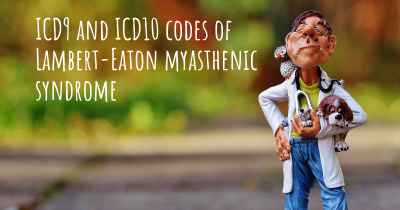What is the life expectancy of someone with Lambert-Eaton myasthenic syndrome?
Life expectancy of people with Lambert-Eaton myasthenic syndrome and recent progresses and researches in Lambert-Eaton myasthenic syndrome

Lambert-Eaton myasthenic syndrome (LEMS) is a rare autoimmune disorder affecting the neuromuscular junction. While it can significantly impact a person's quality of life, it is important to note that life expectancy in LEMS varies widely depending on various factors. The syndrome is often associated with an underlying malignancy, and if left untreated, it can lead to severe complications. However, with advancements in medical treatments and management strategies, individuals with LEMS can experience improved outcomes and a relatively normal lifespan. It is crucial for patients to receive appropriate medical care, including regular monitoring and treatment of any underlying conditions, to optimize their health and well-being.
Lambert-Eaton myasthenic syndrome (LEMS) is a rare autoimmune disorder that affects the neuromuscular junction, leading to muscle weakness and fatigue. It is caused by an abnormal immune response that mistakenly attacks the voltage-gated calcium channels in the nerve cells, impairing the release of neurotransmitters.
The life expectancy of individuals with LEMS can vary depending on several factors, including the severity of the disease, the presence of underlying conditions, and the effectiveness of treatment. It is important to note that LEMS is a chronic condition, and while it can significantly impact a person's quality of life, it is not typically considered a life-threatening disorder.
Prognosis:
The prognosis for individuals with LEMS has improved over the years due to advancements in medical understanding and treatment options. With appropriate management, many individuals with LEMS can lead fulfilling lives and have a near-normal life expectancy.
Treatment:
The primary goal of treatment for LEMS is to alleviate symptoms and improve muscle strength and function. This is typically achieved through a combination of symptomatic treatment and immunomodulatory therapy.
Symptomatic treatment:
Medications such as 3,4-diaminopyridine (3,4-DAP) or amifampridine can be prescribed to enhance the release of neurotransmitters, thereby improving muscle strength and reducing weakness. These medications can significantly improve the symptoms of LEMS and enhance the overall quality of life for individuals with the condition.
Immunomodulatory therapy:
Immunomodulatory therapies, such as corticosteroids, intravenous immunoglobulin (IVIG), or plasma exchange, may be used to suppress the abnormal immune response and reduce the attack on the neuromuscular junction. These treatments can help manage the underlying autoimmune component of LEMS and improve muscle function.
Underlying conditions:
It is important to consider any underlying conditions that may be present alongside LEMS, as they can impact life expectancy. LEMS is often associated with an underlying malignancy, particularly small cell lung cancer (SCLC). In cases where SCLC is present, the prognosis may be influenced by the stage and treatment response of the cancer.
Overall:
While LEMS can significantly affect a person's daily life and mobility, it is generally not considered a life-threatening condition on its own. With appropriate treatment and management, individuals with LEMS can experience improved muscle strength and function, leading to an enhanced quality of life. It is important for individuals with LEMS to work closely with their healthcare team to develop a personalized treatment plan and regularly monitor their condition.








